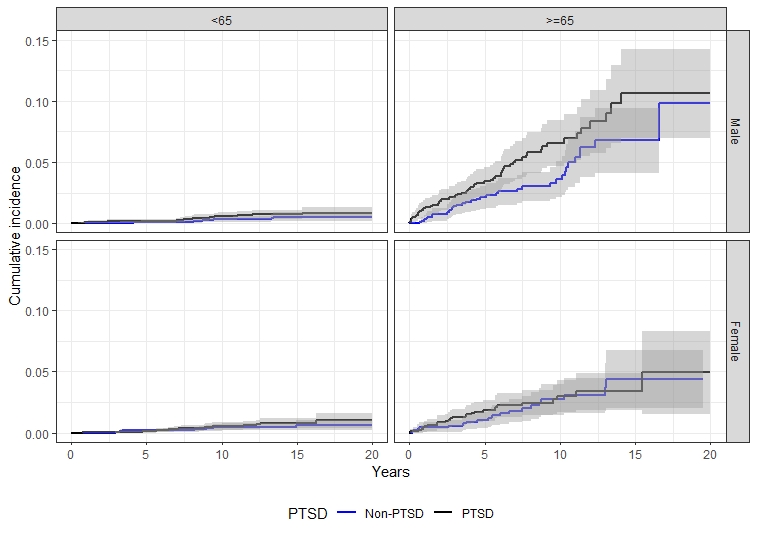Category: Epidemiology
Objective: Evaluate the impact of post-traumatic stress disorder(PTSD) on the risk of Parkinson’s Disease(PD) based on long follow-up real world data.
Background: Traumatic events with subsequent PTSD were associated to PD in a few studies.
Method: Retrospective cohort analysis of the electronic-medical recordings second largest health plan in Israel, identified PTSD patients born before 1970 who met criteria of PTSD diagnosis given by a psychiatrist, psychologist, or neurologist; Patients were included if they had first PTSD diagnosis in 2000-2015 and prior to the diagnosis of PD. All eligible PTSD patients were matched to non-PTSD members 1:1, by age and sex. For PTSD cases, index date was defined as date of first PTSD diagnosis, and was given also to their non-PTSD control.
Results: We identified 8336 PTSD patients, male – 51.6%. Mean age at PTSD diagnosis was 55.8 years (standard deviation[SD]=13.2). Mean age at first PD diagnosis was 76.2 years (SD=9.9). Overall, mean time to PD development was 19.7 years (95%confidence interval[CI]:19.7-19.8). As expected, compared to patients not developing PD, patients who developed PD (n=196) were older at index date (mean age:70.5 vs. 55.6), they were more likely to be male (61.7% vs. 51.5%), have cardiovascular-disease, diabetes, hypertension and depression and less likely to be smokers at index date (4.1% vs. 13.3%), p<0.05 for all comparisons. Additional unexpected risk factors were epilepsy and high percent of the Holocaust (21.9% vs. 8.7%). In a univariate analysis, PTSD patients had 1.45-fold (95%CI:1.09-1.9, p<0.001) risk for PD and 1.48-fold risk (95%CI:1.1-1.9, p=0.01) in multivariable analysis. After stratification for age at index date and sex, PTSD was shown to impact the risk for PD only in men, diagnosed with PTSD after the age of 65 years (Hazard Ratio=1.76, 95%CI:1.15-2.7, p=0.009) [Figure1].
Conclusion: Results of our 20 years’ follow-up suggest that PTSD increase risk of PD in males that developed PTSD after age of 65. This finding adds additional group to the population at special risk for PD. In light of high and constantly growing prevalence of traumatic exposure worldwide, it can be important for design of disease modifying therapies and may be additional step towards personalized medicine in PD. Further studies are needed to evaluate the nature of the of PTSD-PD association.
To cite this abstract in AMA style:
Y. Barer, G. Chodick, T. Gurevich. Post-Traumatic Stress Disorder and risk of Parkinson’s Disease– 20 Years Follow-up real world data analysis [abstract]. Mov Disord. 2021; 36 (suppl 1). https://www.mdsabstracts.org/abstract/post-traumatic-stress-disorder-and-risk-of-parkinsons-disease-20-years-follow-up-real-world-data-analysis/. Accessed November 14, 2025.« Back to MDS Virtual Congress 2021
MDS Abstracts - https://www.mdsabstracts.org/abstract/post-traumatic-stress-disorder-and-risk-of-parkinsons-disease-20-years-follow-up-real-world-data-analysis/

